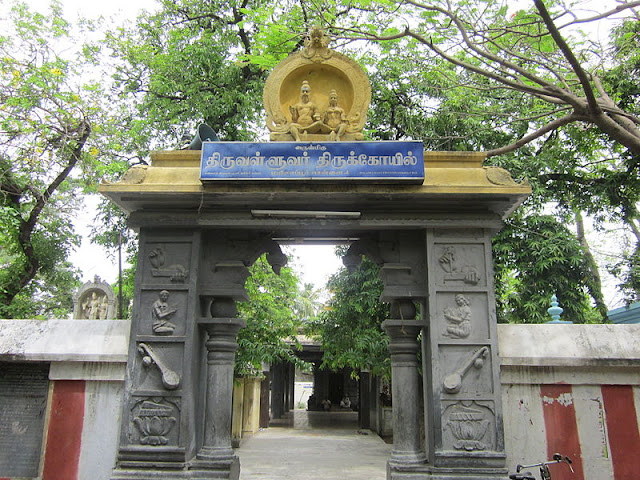Thiruvalluvar Temple, Mylapore, Chennai
Thiruvalluvar
Temple is a Hindu
temple dedicated to Tamil Poet-Saint
Thiruvalluvar, Author of Thirukural located at Mylapore in Chennai City in
Tamilnadu. The temple is located in a narrow lane adjacent to the Valluvar
statue on Royapettah High Road. It is relatively unknown to many that there exists a
temple for the saint composer Thiruvalluvar, at the heart of the Chennai City in
Mylapore, where he was born and lived. Some call it a memorial while others
consider it as a temple for Thiruvalluvar, who had immortalized his work in
1330 couplets, which was translated in all well-known languages, inland and
abroad by eminent scholars.
Legends
There is
a famous incident in Thiruvalluvar-Vasuki life in which, while Vasuki was
fetching water in a pot from a well, Thiruvalluvar called her and she went
leaving the pot as it was but incidentally the pot remained half way as it was.
This historical well can be seen here, but there is no water now and is closed
with sand. It is also covered with a steel grill for safety reasons.
When
death separated his wife, Vasuki Ammaiyar from Thiruvalluvar, the saint,
laments like all other commoners, unable to bear the grief of her separation.
The poet, noted for his unique style of the couplets in Tamil, changes to
quatrain, which he did only once, and dedicates this verse, to his bereaved
wife.
அடியிற்கினியாளே அன்புடையாளே
படிசொல் தவறாத பாவாய்- அடிவருடி
பின்தூங்கி முனெழும் பேதாய் இனிதா ய்
என் தூங்கும் என் கண் இரவு
The
quatrain roughly means: My sweetheart, dear lady, you never
failed in (your) words, gently pressed my feet, slept late, got up early (my)
innocent, sweet one, How can my eyes sleep at nights?
History
This is
a memorial believed to have been constructed in the early 16th century, the
temple was extensively renovated in the 1970s. As a book on Mylapore temples
published in 1929 refers this temple as Thiruvalluvar temple, we could safely
assume that this temple is older than 1929 CE. But people considered
Thiruvalluvar as God and performed poojas and changed the memorial in to a
temple. Hence, it is called Thiruvalluvar Temple. In his book called
Thirumayilayin Thirukoilgal, published in 1989, Dr. S. Rajendran believes that
the temple was built in the early part of the 16th Century. This is
not evident, as the temple was extensively renovated in the early 1970s and
most of the stone structures were replaced by concrete.
The
Temple
This
Temple is a simple, two-roomed shrine enclosed by an open-pillared
portico. The east facing sanctum enshrines big idol for Thiruvalluvar. The
stone idol appears to be old. It's interesting to find the stucco idols of
Valluvar on his own vimana. The bronze idols of Valluvar and his wife Vasuki
are also located in the sanctum. As part of the grand Mylapore annual festival
(of the famous Kapaleeshwarar temple), on the 8th day of the festival, the
bronze idol of Valluvar is also taken into procession along with 63 Nayanmars.
Vasuki
is found in a separate east facing shrine, which is found on the left side of
the sanctum. A holy tree with a lot of snake stones and a stucco image of Mari
Amman is found. There is a larger than life marble statue of Thiruvalluvar in
sitting posture and of his parents Sri Adi and Sri Bhagavan, with Sri Adi
holding him as a child in her arms and kneeling before her husband. A cylinder
with an inscription (dated 1935 CE) that reads that it was the base of the
Iluppai tree where the poet was born, is found on the pedestal.
This
Tree is located just by the side of the Maha Mandapam or the Meditation Hall
This Iluppai Tree is more than 2000 years old Iluppai tree under which
Thiruvalluvar is said to have born got damaged in 1935 and the base of the tree
is being protected with a cover. There is a separate shrine for Ekambareswarar
Shiva Linga. The sub-shrine of Kamakshi is located near this shrine. The koshta
images of Dakshina Murti, Lingodhbava, Brahma and Durga are found on the wall
of the shrine.
The
niche images of Ganesh and Subramanya-Valli-Devasena are found at the entrance.
The stucco image depicting Valluvar worshiping Shiva and Parvati on the lintel
is interesting. Valluvar is treated on par with the other Saivite saints. The
small sub-shrines of Hanuman, Ganesh, Chandikeswara, Bhairava, Saneeswara and
Navagraha are also found in this temple. The Ekambareswarar shrine is
considered as the birth place of Thiruvalluvar by some researchers and as the
Samadhi by others. This temple is completely dedicated to his contribution to
Tamil literature. Classes on the Thirukural are also held in the evenings for
children.
To the
rear, near a neem tree surrounded by naga statues, was a shrine for Amman. All
these suggest that the temple was originally a village temple that slowly
gained prominence as a Shiva temple and then became the shrine for Thiruvalluvar.
Except for the stone idols, there are no traces of the structure of the
original temple after the renovation by the Government. The processional deity
of Ekambareswarar is stored in a temple vault and the ones of Thiruvalluvar and
Vasuki are clearly a century or two old.
Connectivity
For
brief details, please refer below link;
http://tamilnadu-favtourism.blogspot.com/2017/12/thiruvalluvar-temple-mylapore-connectivity.html

















